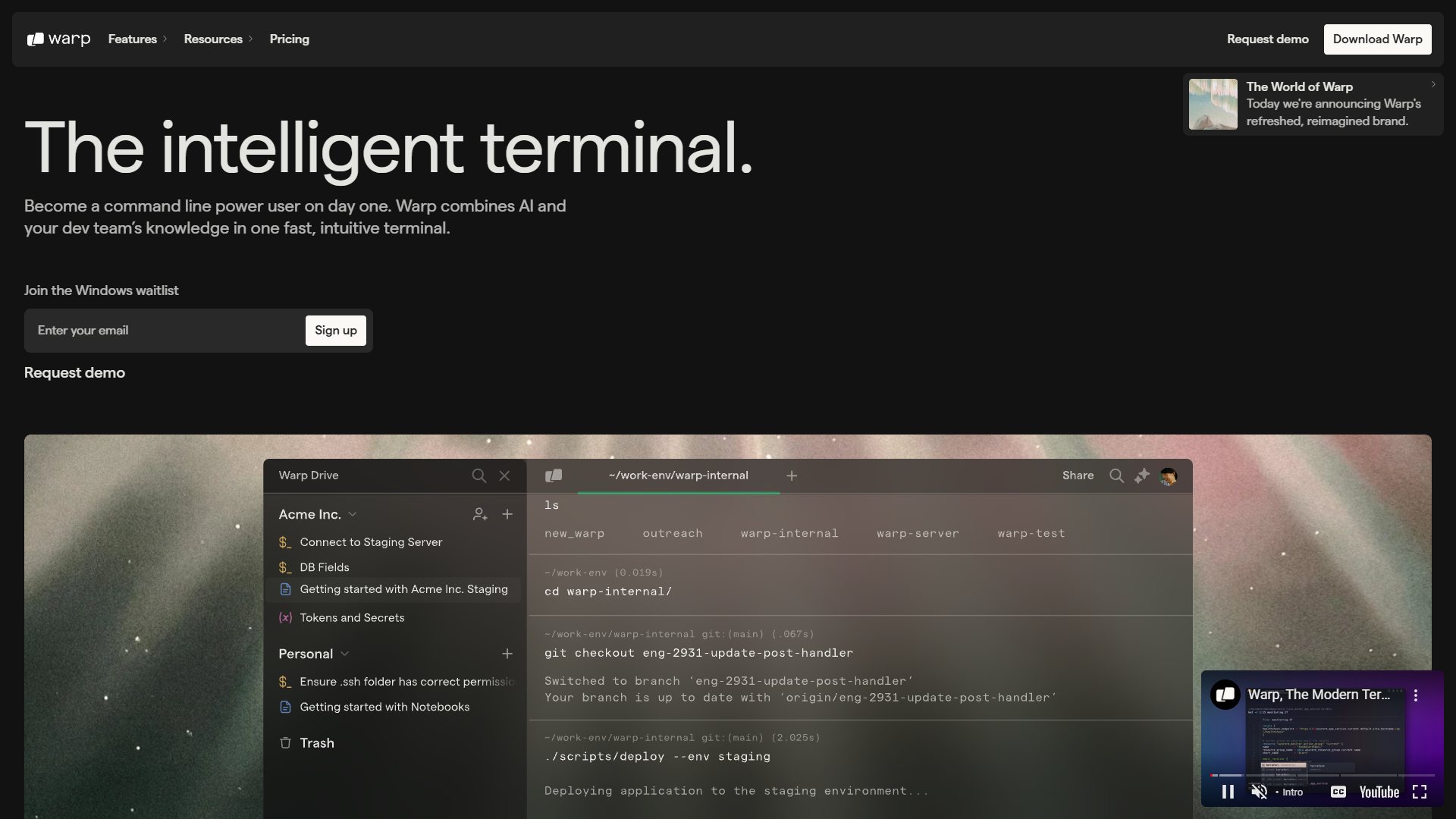Overview
Warp brings a fresh and powerful approach to terminal usage, designed specifically for developers and engineers who demand more from their command interface. By integrating an IDE-like input editor, Warp enhances the way users interact with their terminal, making command editing and navigation significantly faster and more intuitive. It stands out by offering AI-driven functionalities, such as intelligent command suggestions with Warp AI, which learns from the users' own documentation to provide a more personalized experience.
Beyond the traditional terminal features, Warp provides Agent Mode that allows users to communicate and delegate tasks to AI using natural language, further simplifying and accelerating workflow processes. Warp Drive is another unique highlight, offering the capability to save and share interactive notebooks and workflows, maintaining a seamless development environment. With robust features like offline capability, real-time session sharing, and stringent data privacy measures, Warp is not just a productivity booster but also a reliable tool for collaborative and secure development.
Furthermore, by ensuring that user data remains between the user and the AI, Warp emphasizes security and compliance, garnering trust among enterprises and individual users alike. With such innovative features tightly packed, Warp redefines what’s possible in a terminal environment, making it an indispensable tool for modern tech professionals.
Key features
- Modern input editor: Warp enhances terminal interaction with its IDE-like input editor, allowing developers to edit and navigate commands with exceptional speed and precision, optimizing the overall workflow experience.
- AI command suggestions: With Warp AI, users receive intelligent command suggestions tailored to ongoing tasks, improving accuracy and efficiency by learning from the user's past command history and documentation.
- Agent Mode for tasks: This feature allows developers to use natural language to communicate with the AI, delegating tasks seamlessly within the command line environment, significantly speeding up task completion.
- Warp Drive sharing: Warp Drive provides users with the ability to save and share interactive notebooks and workflows, enhancing collaboration and ensuring that team members remain on the same page.
- Offline terminal features: Offering offline access to essential terminal capabilities, Warp ensures uninterrupted productivity regardless of internet connectivity, crucial for developers in varied environments.
 Pros
Pros
- Real-time session sharing: Warp allows real-time session sharing, enabling teams to collaborate live, view edits instantly, and streamline communication effectively within a shared terminal interface.
- Strong privacy measures: User privacy is prioritized with policies like zero data retention, ensuring that sensitive data is processed securely without being stored or used for training AI models.
- High AI request limit: The tool offers generous AI request limits for users, allowing up to 1,000 requests in the Pro plan, facilitating extensive use of AI functionalities without immediate restrictions.
- Comprehensive support options: Warp provides a range of support options, from public forums to private email support and dedicated onboarding assistance, catering to user needs efficiently.
- Customizable work environment: Users have options to customize their interface with themes and keybindings, tailoring Warp to fit personal or team preferences and operational requirements effectively.
 Cons
Cons
- Primarily for technical users: Designed with engineers and developers in mind, Warp's advanced features may not be suitable for non-technical users who are unfamiliar with terminal and command line operations.
- Limited free AI requests: While the free plan is generous for initial use, it restricts AI requests to 100 per month, which might be insufficient for power users needing extensive AI interaction.
- Requires internet for AI: To utilize AI functionalities, Warp requires an internet connection to process requests with OpenAI APIs, potentially limiting use in offline scenarios where AI features are desired.
- Complexity in team setup: Setting up for broader team operations can be complex, requiring familiarization with various collaborative features and settings, which may pose challenges during initial stages.
















